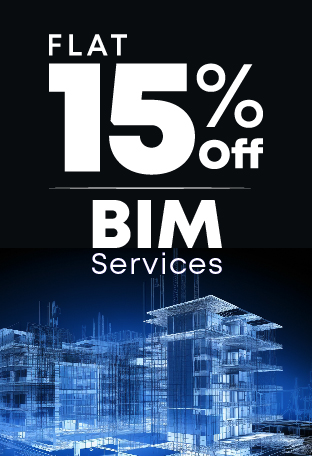Design professionals and firms are now being faced with the exciting and quantifiable advantages of this revolutionary technology. Better known as BIM or Building Information Modeling, it is also known as Simple Building Modeling (SBM) and Virtual Building Modeling (VBM).
Computers and technology have so far been used in the building and design industry .Recent developments have put forth the myriad advantages of modeling not only the graphical aspect but also the non-graphical aspect of building design life cycle.
The objective here seems to be to improve user productivity by making building design and project execution faster, cheaper and more efficient. Implementation of BIM technologies called for a strategic shift in the business functioning model followed so far. Firms have created strategy frameworks that help them to readily adjust to the practical realities of BIM implementation.
Most employees within these organizations are accustomed to working around or with familiar touch points such as sheet layout templates and line blocks for printing. Implementation of a radically different comprehensive technology within this environment called for insightful strategy decision making on the part of the management.
Most importantly, making use of the available knowledge and experience to execute implementation without disturbing the existing working model formed the core of this strategy.
In addition, dual platforms functioning within the same office pose a staffing challenge. With a single software platform such as CAD, any staff member is available to work on a relevant project.
However, in the implementation of BIM software, only a small pool of team members would be available. Therefore, pilot projects of BIM or training in BIM need to be carefully selected according to the size, schedule and team member availability. This division of team member could cost an organization team efficiency and billable time.
Large and medium firms can afford the luxury of aligning teams to BIM, as they would have some supplement workforce at certain points of time. Smaller firms would find this difficult to achieve.
As they would be unable to commit an entire team to BIM software at a time or even over a period of time. A viable option for them would be to seek offshore expertise in this regard. Leveraging outside experience and expertise would help them keep their teams intact, facilitate better integration of BIM technologies within their business model and save a whole lot of billable hours.
Though BIM software offers quantifiable advantage, its adoption percentage has been quite low. It is on an accelerating track now – BIM usage grew by three percent in 2003, six percent in 2005 and 11 percent in 2006.* Nevertheless, challenges have been cited in the path of this growing rate of BIM implementation.
As opposed to traditional 2D CAD systems, BIM systems are more complex. Existing professionals are well versed with using capable drafting tools such as CAD systems. Absence of industry standards are also considered a hindrance to collaborative construction processes and effective BIM implementation. Along with this, a lack of expertise also poses a challenge to firms who wish to shift to BIM software.
Adopting and implementing BIM software is quite a challenge, but once executed BIM gives a power dose to productivity. BIM facilitates the creation of visualizations, sections and elevation freely and helps incorporate this information further down in the construction process.
Obviously, the challenges arise not regarding the capability of BIM software but in effectively implementing this software within existing systems and training and equipping teams with the necessary skills to leverage its many advantages.
BIM is a complex software, design teams seldom have the time to learn and adopt complex systems. Also, most of the new programs are built for people with in-depth knowledge of how buildings are made.
BIM provides certain foundation element opportunities:
- Virtually design or edit existing structures/facilities
- Eliminate problems and predict performance
- Virtually stimulate construction and operation prior to physical execution
- Coordinate design documentation
- Coordinate construction to reduce construction time and eliminate change orders
- Enter one-time data as part of the process and re-use it throughout the lifecycle and beyond
- Strategic planning by harvesting business intelligence and operational information
- Blend geospatial and building information for planning, development and emergency response
- Harvest building information for use in programming and design
BIM assists in significantly reducing lifecycle time by facilitating better communication and management of delivery times. When adopted along with lean concepts, BIM helps reduce lifecycle cost. According to Ghafari Associates Inc., the wastages in construction include:
- Correction – Rechecking and redoing errors occurring in design but discovered only at the construction stage
- Over-production – Executing task ahead of schedule thus interfering with other practical, scheduled work
- Motion – Time and effort lost in transit due to team moving from and to the office picking up plans, tools or materials
- Material movement – moving material from one stage to another or from one crew to another
- Waiting – Teams waiting for equipment, plans, instruction, materials etc
- Processing – Unnecessary reporting, expediting material orders, or excessive coordination
- Inventory – Material staged too far in advance on site
Cost savings from BIM implementation
Implementation Strategies
Introducing and implementing BIM can be quick and painless, if preceded with the right amount of planning and preparation. This ‘right amount’ will be decided entirely based on each individual firm’s functioning and objectives. Just like every architect, firm and design are unique and different, BIM implementation for each firm; architect and designer would also be unique and different.
Smaller firms face bigger challenges their larger counterparts as they would find it difficult to shift their production staff to other studios. Therefore, drafters and team members must be amenable to workflow changes. For small firms BIM implementation requires critical planning and dedicated execution of these plans.
Also, they must be aware of methods to measure the success and failure of this implementation planning and strategy. This planning requires insight into the short terms project schedules. Measuring the success or failure of the implementation can be judged by recreating a previous design using new technology and procedures.
Budget requirements are also a hindrance for smaller firms. When implementing new software, hardware such as work stations and server might also call for up gradation. In addition, the billable hours lost during system rollout is always a concern, particularly for smaller firms with shorter project timelines.
Smaller firms can therefore, look to leverage offshore expertise and infrastructure investments regarding BIM implementation. As these firms are specialists in BIM technology, they wield fully equipped studios and knowledgeable team of professionals to handle every requirement.
What to do
Step 1
- Determine your stake and maximum advantage derivable from
- Enhancing value services
- Reduce cycle time and improve efficiency
- Better coordination between design, construction and operations
- Determine cost savings derived by not implementing BIM
- Determine how competition is coping with or without BIM
- Leverage innovation offered by way of offshoring BIM integration, professional associations and industry organizations
Step 2
- Invest in education and training or hiring outside help
- Adopt available standards such as National CAD Standard, Omniclass™, UniFormat II etc
- Support and participate standard development
- Seek contracts that reward value enhancement
- Require and support higher functioning facilities
With an intelligent implementation of BIM technology, your team starts to develop skills and techniques, build confidence in the software; reevaluate current projects and judge and pace the future work for potential benefits and added services. This confidence gives your firm the edge needed to survive in an ever changing, ever growing marketplace.
*Source: Realtytimes.com/rtpages/20071224_modeladopt.htm







 How AI BIM Modeling Shaping the Future of Residential Construction?
How AI BIM Modeling Shaping the Future of Residential Construction?  How BIM Services Enhance Collaboration, Design Choices, and Project Efficiency for Architects? – A Guide
How BIM Services Enhance Collaboration, Design Choices, and Project Efficiency for Architects? – A Guide  How is Artificial Intelligence in Construction Design Transforming Architectural Landscape?
How is Artificial Intelligence in Construction Design Transforming Architectural Landscape?  BIM Coordination Benefits for Contractors in the Preconstruction Stage
BIM Coordination Benefits for Contractors in the Preconstruction Stage